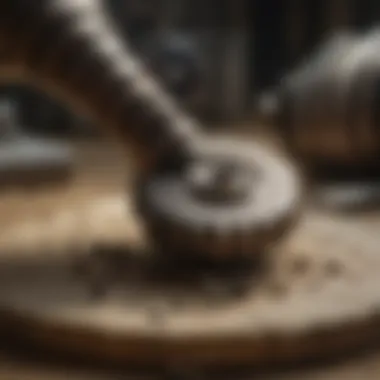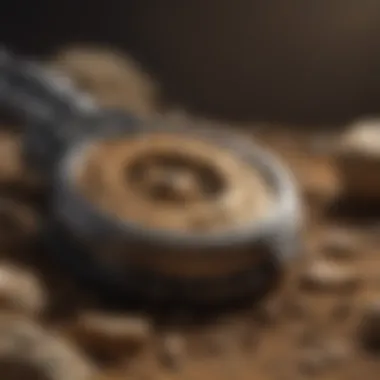Unveiling the Power of Dremel-Like Tools for Rock and Fossil Enthusiasts


Rock and Fossil Identification
As a rock and fossil collector, understanding the types of rocks and fossils is essential. Various characteristics differentiate rocks and fossils, influencing their value and rarity. Tools for identification play a crucial role in this process, aiding collectors in accurately assessing and cataloging their discoveries.
Collecting Tips and Techniques
Delving into the world of rock and fossil collection requires adherence to best practices. Knowing where to find prime collecting sites elevates the likelihood of uncovering unique specimens. Additionally, learning how to safely extract specimens is paramount; it ensures the preservation of delicate fossils and prevents damage to valuable rocks.
Preservation and Display
Preserving rocks and fossils is a meticulous task that demands attention to detail. Employing various techniques ensures that specimens retain their integrity over time. Proper storage methods further safeguard the collection, preventing degradation or deterioration. For those looking to showcase their finds, creative display ideas can bring a unique touch to the presentation, enhancing the aesthetic appeal of the collection.
Geological Insights
Exploring geological formations and processes provides valuable context to rock and fossil collectors. Understanding the historical significance of rocks and fossils adds layers of depth to the collection, connecting enthusiasts to the earth's rich past. Reflecting on notable discoveries in the field offers inspiration and sparks curiosity, driving further exploration and research.
Introduction to Dremel-Like Tools
In the fascinating realm of rock and fossil collection, the significance of Dremel-like tools cannot be overstated. These precision instruments serve as indispensable aids for enthusiasts and professionals seeking to elevate their craft to new levels of artistry and meticulous detail. When delving into the world of rock and fossil collection, understanding the tools at hand is paramount to success.
Understanding the Role of Tools in Rock and Fossil Collection
Precision and Versatility
Precision and versatility are two key pillars that uphold the essence of Dremel-like tools in the context of rock and fossil collection. The ability to execute intricate tasks with utmost accuracy and adaptability is a game-changer for enthusiasts who demand excellence in their work. The precision offered by these tools allows collectors to delicately carve out intricate details on rocks and fossils, bringing out their natural beauty with unparalleled finesse. Additionally, the versatility of Dremel-like tools enables users to effortlessly transition between various attachments and power settings, catering to an array of tasks with efficiency and ease.
Efficiency in Detail Work
Efficiency in detail work is another crucial aspect that sets Dremel-like tools apart in the realm of rock and fossil collection. These tools excel in handling detailed tasks with precision and speed, making them indispensable for intricate projects that require meticulous craftsmanship. The ability to efficiently carve, engrave, or polish surfaces ensures that collectors can achieve impeccable results in a fraction of the time it would take with traditional tools. The efficiency in detail work offered by Dremel-like tools not only saves time but also enhances the overall quality and finesse of the final product.
Overview of Dremel-Like Tools
Key Features and Components
When exploring Dremel-like tools, one cannot overlook the significance of their key features and components. The design of these tools is meticulously crafted to offer ergonomic comfort, easy handling, and precise control, essential elements that contribute to a seamless user experience. From adjustable speed settings to interchangeable collets, the key features of these tools enhance versatility and performance, ensuring that rock and fossil collectors can tackle a wide range of tasks with proficiency and ease.


Types of Attachments
The variety of attachments available for Dremel-like tools further expands their utility in rock and fossil collection. Each type of attachment serves a specific purpose, whether it's cutting, grinding, sanding, or polishing, allowing users to tailor their tool setup to the task at hand. From diamond-coated bits for detailed sculpting to buffing wheels for surface polishing, the types of attachments available for these tools provide collectors with a versatile arsenal to bring their creative visions to life.
Benefits of Using Dremel-Like Tools
Enhanced Precision
The enhanced precision offered by Dremel-like tools revolutionizes the way rock and fossil collectors approach their craft. With unmatched accuracy and control, users can execute intricate detailing work with finesse, enhancing the beauty and authenticity of their specimens. Whether it's delicately removing excess matrix or etching intricate patterns, the enhanced precision of these tools elevates the level of craftsmanship and attention to detail in rock and fossil collection.
Time-Saving Advantages
In the world of rock and fossil collection, time is of the essence, and Dremel-like tools offer invaluable time-saving advantages. The efficiency with which these tools handle detail work translates to faster completion of tasks without compromising quality. From quickly shaping fossils to precisely engraving display pieces, the time-saving advantages of Dremel-like tools empower collectors to streamline their work processes and focus on unleashing their creativity without constraints.
Choosing the Right Tool for the Job
Factors to Consider
Material Composition
When delving into material composition, rock and fossil collectors are immersed in a world where the choice of material can make or break the outcome of their work. Different materials offer unique advantages and challenges, impacting the final results significantly. Understanding the properties and characteristics of materials is essential; whether opting for durability, flexibility, or precision, collectors must assess the suitability of the material composition for each specific task. While some materials may excel in shaping intricate details, others might be better suited for more robust work, each playing a vital role in the collector's tool selection process.
Nature of Work
The nature of work in rock and fossil collection encompasses a wide spectrum of tasks, each requiring a tailored approach to achieve optimal results. From delicate polishing to intricate detailing, collectors must align the tools with the demands of the job to ensure seamless execution. Factors such as the size of the specimens, the intricacy of the design, and the overall objectives of the project are crucial considerations when determining the appropriate tools for the task. Matching the nature of the work with the capabilities of the tools leads to enhanced precision and efficiency, streamlining the collection and preservation processes for rock and fossil enthusiasts.
Comparing Different Models
Power Options
In the realm of dremel-like tools, power options play a vital role in dictating the capability and performance of the tools. The power source of a tool influences its strength and speed, impacting its effectiveness in various applications. Collectors must weigh the benefits of corded versus cordless models, considering factors such as portability, power output, and runtime to make informed decisions based on their specific needs and preferences. Whether opting for a high-powered corded tool for intensive carving or a versatile cordless model for on-the-go detailing, understanding power options is key to selecting the right tool for the job.
Speed Settings
Speed settings in dremel-like tools offer collectors the flexibility to adapt to different tasks and materials seamlessly. By adjusting the speed settings, collectors can customize the tool's performance to suit the intricacy and requirements of each project, ensuring optimal results with every stroke. Whether working on soft rock surfaces that require gentle precision or tackling tougher materials that demand higher speed, having control over the tool's speed settings empowers collectors to achieve the desired outcomes efficiently. Understanding the correlation between speed settings and task requirements is essential for rock and fossil collectors aiming for precision and quality in their work.


Safety Precautions and Maintenance
Protective Gear
Prioritizing safety in rock and fossil collection activities is paramount, with protective gear playing a pivotal role in ensuring a secure working environment. From eye protection to dust masks, collectors must equip themselves with the appropriate gear to safeguard against potential hazards and minimize risks during their projects. Understanding the importance of protective gear and adhering to safety protocols not only protects collectors from injuries but also enhances the overall efficiency and quality of their work, creating a secure foundation for engaging in collection and preservation activities.
Cleaning and Storage Tips
Effective cleaning and proper storage are essential aspects of maintaining dremel-like tools and preserving collected specimens. Implementing regular cleaning routines and adopting suitable storage practices prolong the lifespan of tools and specimens, ensuring longevity and quality in collection endeavors. By following specific cleaning procedures that target different kinds of residues and utilizing proper storage containers that prevent damage and degradation, rock and fossil collectors can uphold the integrity of their tools and specimens, showcasing their collection with pride while maintaining the tools in optimal working condition.
Applications in Rock and Fossil Collection
In the realm of rock and fossil collecting, the applications of dremel-like tools hold a pivotal role in enhancing the precision and efficiency required for meticulous work. Cleaning and detailing specimens is a crucial aspect of this field, as it involves tasks such as removing excess matrix and polishing surfaces to uncover the intricate details within each piece. Customizing display pieces further elevates the artistry and presentation of collected items, with techniques like engraving and creating intricate designs adding a personalized touch. Additionally, the ability to perform repair and restoration work using these tools ensures that damaged specimens can be meticulously maintained and preserved for years to come.
Cleaning and Detailing Specimens
Removing Excess Matrix
Removing excess matrix from specimens is a precise task that demands detailed attention to ensure the preservation of the fossil or rock underneath. This technique allows collectors to uncover hidden details without causing damage to the specimen. The key characteristic of proficiently removing excess matrix lies in the dremel-like tool's ability to delicately sculpt away the surrounding material while leaving the specimen intact. This method is highly beneficial as it enables collectors to expose intricate features effectively, though care must be taken to avoid accidental damage during the process.
Polishing Surfaces
Polishing surfaces is essential in rock and fossil collection to reveal the natural luster and beauty of specimens. With dremel-like tools, collectors can achieve smooth and gleaming surfaces that showcase the details effectively. The key characteristic of polishing surfaces is the ability to finesse rough areas and imperfections, bringing out the inherent elegance of each specimen. While this process is popular for its transformative effects, it requires precision to avoid over-polishing and potentially altering the specimen's original structure, making it essential to exercise caution and skill.
Customizing Display Pieces
Engraving Techniques
Utilizing engraving techniques allows collectors to add personalization and flair to their display pieces, making each item unique and visually engaging. The key characteristic of engraving lies in the tool's capability to create intricate designs with precision, enhancing the aesthetic appeal of the specimen. This technique is popular for its ability to provide a customized touch to displays, though consistency in pressure and depth is vital to ensure the desired outcome without compromising the specimen's integrity.
Creating Intricate Designs
Creating intricate designs through dremel-like tools enables collectors to express creativity and artistry in their displays. The key characteristic of this method is the precision required to execute detailed patterns and motifs effectively. This technique is beneficial for enhancing the visual appeal of specimens and adding a personalized touch to each display piece; however, it demands patience and skill to achieve intricate designs without causing accidental damage to the specimen.
Repair and Restoration Work


Filling Cracks
The process of filling cracks in specimens is crucial for maintaining their structural integrity and aesthetics. By using dremel-like tools to fill cracks with matching material, collectors can seamlessly repair damaged areas and prevent further deterioration. The key characteristic of filling cracks is the tool's ability to blend the filler material seamlessly with the specimen, ensuring a cohesive finish that preserves the specimen's natural beauty. While this technique is popular for its ability to restore damaged specimens, meticulous care must be taken to match materials accurately and avoid altering the specimen's original composition.
Reconstructive Procedures
Engaging in reconstructive procedures using dremel-like tools allows collectors to restore severely damaged specimens to their former glory. This technique involves meticulous sculpting and shaping of filler material to reconstruct missing parts or sections of the specimen. The key characteristic of reconstructive procedures is the precision and artistry required to seamlessly integrate the filler material with the specimen, creating a harmonious restoration. While this method is advantageous for salvaging extensively damaged specimens, it demands a steady hand and careful attention to detail to ensure a seamless and natural-looking outcome.
Advanced Tips and Techniques
In delving into the realm of Dremel-like tools for rock and fossil collectors, it becomes evident that mastering advanced tips and techniques is paramount in enhancing one's skillset. These specialized methods offer a deep dive into the intricacies of tool usage, elevating the entire collection and preservation process. By focusing on advanced tips and techniques, collectors can achieve heightened precision, efficiency, and innovative approaches that set their work apart from the ordinary. Exploring nuances such as etching, texturing, coloring methods, layering effects, mixed media approaches, troubleshooting common issues like overheating problems and attachment compatibility, allows for a holistic understanding of the tools at hand.
Artistic Applications
Etching and Texturing
Delving into the intricate world of etching and texturing within rock and fossil collection unveils a realm of creativity and precision. This process involves meticulously carving delicate details onto surfaces, adding depth and character to specimens. The key characteristic of etching and texturing lies in its ability to transform a plain surface into a visually captivating masterpiece. With its precise nature, etching and texturing serve as a popular choice for collectors aiming to add a unique touch to their pieces. While this technique demands patience and a steady hand, its advantages in enhancing the overall aesthetics of fossils and rocks make it a valuable asset in this field.
Coloring Methods
Coloring methods offer a creative avenue for collectors to infuse vibrancy and life into their specimens. By carefully selecting and applying colors, collectors can highlight intricate details, differentiate features, and create stunning visual contrasts. The key characteristic of coloring methods is their ability to enhance the beauty and realism of specimens, bringing out hidden patterns and textures. This approach is a beneficial choice for collectors looking to customize their pieces or emphasize specific aspects of their collection. While coloring methods require a delicate touch and an eye for detail, the advantages of adding vibrant hues to rocks and fossils are undeniable, making it a preferred technique among enthusiasts.
Innovative Tool Combinations
Layering Effects
Exploring the possibilities of layering effects introduces collectors to a realm of depth and complexity in their work. This approach involves overlaying materials or textures to create a multidimensional appearance, adding depth and visual interest to specimens. The key characteristic of layering effects is their ability to transform a flat surface into a dynamic and textured masterpiece. Due to its versatility and ability to add depth to designs, layering effects stand as a popular choice for collectors seeking to elevate the impact of their creations. While mastering this technique requires careful consideration of materials and textures, the advantages of creating visually stunning and intricate pieces through layering effects make it a compelling option for rock and fossil collectors.
Mixed Media Approaches
Embracing mixed media approaches opens up a world of possibilities for collectors to experiment with various materials and techniques. By combining different mediums such as paints, metals, or organic elements, collectors can achieve unique textures, colors, and effects in their work. The key characteristic of mixed media approaches is their ability to push the boundaries of traditional collection methods, allowing for innovative and eclectic creations. This approach is a beneficial choice for collectors who seek to break away from conventional styles and incorporate a range of materials into their pieces. While mixed media approaches require a thoughtful blend of elements and techniques, the advantages of creating diverse and visually intriguing specimens make it a valuable technique for those looking to expand their artistic horizons.
Troubleshooting Common Issues
Overheating Problems
Addressing the issue of overheating when using Dremel-like tools is essential for ensuring the longevity and efficiency of the equipment. Overheating problems can arise during prolonged use or when working on dense materials, compromising the tool's performance and potentially damaging the specimen. The key characteristic of overheating problems is their impact on the tool's functionality and the quality of the work produced. By recognizing the signs of overheating and implementing proper cooling techniques, collectors can mitigate the risk of thermal damage and maintain a consistent workflow. While managing overheating issues requires vigilance and adherence to safety protocols, the advantage of prolonging the tool's lifespan and achieving optimal performance outweighs the challenges, making it a crucial aspect to address in rock and fossil collection.
Attachment Compatibility
Ensuring attachment compatibility with Dremel-like tools is fundamental in optimizing their functionality and versatility for collectors. The compatibility of attachments determines the range of tasks that can be accomplished with the tool, enabling users to seamlessly switch between different accessories and achieve varying effects. The key characteristic of attachment compatibility is its role in expanding the tool's utility and adapting to specific task requirements. By choosing attachments that align with their project needs, collectors can enhance their precision and efficiency in handling diverse materials and surfaces. While assessing attachment compatibility demands a thorough understanding of tool specifications and accessory functions, the advantages of seamlessly transitioning between attachments and maximizing the tool's capabilities make it an indispensable consideration for rock and fossil collectors.







